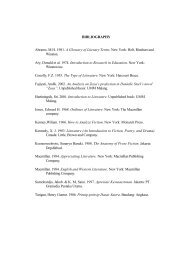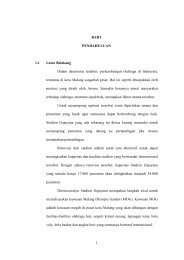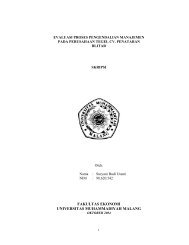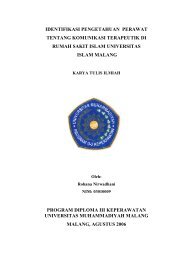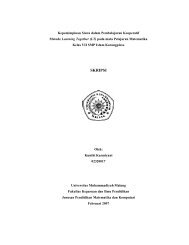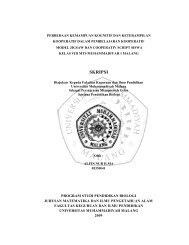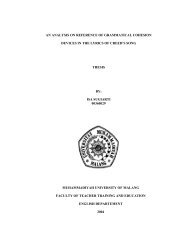File : THESIS.pdf - Universitas Muhammadiyah Malang
File : THESIS.pdf - Universitas Muhammadiyah Malang
File : THESIS.pdf - Universitas Muhammadiyah Malang
You also want an ePaper? Increase the reach of your titles
YUMPU automatically turns print PDFs into web optimized ePapers that Google loves.
assumptions. Trend lines should show an even distribution of points on<br />
either side of the line along its whole length. Lines should be finely drawn<br />
and should not contain kinks or breaks.<br />
Analysis, conclusions and evaluation<br />
Interpretation of data or observations and identifying sources of error<br />
Candidates should be able to:<br />
• describe the patterns and trends shown by tables and graphs;<br />
• describeand summarise the key points of a set of observations;<br />
• find an unknown value by using co-ordinates or axis intercepts on a graph;<br />
calculate other quantities from data or from quantitative data related to their<br />
qualitative observations, or calculate the mean from replicate values, or<br />
make other appropriate calculations;<br />
• determine the gradient of a straight-line graph or tangent to a curve.<br />
• evaluate the effectiveness of control of variables and thus the<br />
confidence with which conclusions might be drawn;<br />
• identify the most significant sources of error in an experiment;<br />
• estimate, quantitatively, the uncertainty in quantitative measurements;<br />
• express such uncertainty in a measurement as an actual or percentage error;<br />
• show an understanding of the distinction between systematic errors and<br />
random errors. Descriptions should be precise, giving quotations of figures to<br />
support the description, and calculated values where these are appropriate.<br />
Unknown values might include unknown concentrations where a calibration<br />
curve has been drawn, or values for 50% plasmolysis or zero change in mass<br />
in osmosis experiments. Calculations may involve mean, percentage,<br />
percentage gain or loss, rate of reaction, magnification, actual size or other<br />
appropriate calculations. When a gradient is to be determined, the points on<br />
the line chosen for the calculation should be separated by at least half of the<br />
length of the line or tangent drawn. Candidates should be used to looking at<br />
experiments and assessing the relative importance of errors in measurementor<br />
in making observations so that they can judge which sources of error are most<br />
important. Candidates should be familiar with simple means of estimating<br />
error, such as the errors intrinsic in measuring devices (see<br />
http://www.chemistryreact.org/go/Tutorial/Tutorial_4428.html)<br />
or in the observer’s ability to<br />
observe, or in experiments where limitations of the method introduce errors<br />
(e.g. heat loss when trying to assess the energy content of biological<br />
materials). They should be able to express these errors in standard forms<br />
such as length = 73 mm ± 1mm, or temperature increase = 14 ˚C ±<br />
4 ˚C. Candidates should be able to suggest which of the sources of error<br />
described are likely to be systematic errors such as those resulting from<br />
thermometers that consistently read 1 ˚C above actual temperature, or<br />
candidates who read volumes to the wrong part of the meniscus, as well as<br />
those which are likely to be random errors due to variability of biological<br />
materials, or random variations in room temperature.<br />
For key control variables, candidates should be able to give a realistic<br />
estimate or appraisal of how effectively the variable was controlled, for<br />
example, how closely the temperature was maintained the same across a<br />
number of samples, and from this, give an indication of the confidence that<br />
they would have in any conclusions drawn.<br />
Drawing conclusions<br />
Candidates should be able to:<br />
• draw conclusions from an experiment, giving an outline description of the<br />
main features of the data, considering whether experimental data supports<br />
a given hypothesis, and making further predictions;<br />
• draw conclusions from interpretations of observations, data and calculated<br />
values;<br />
127



